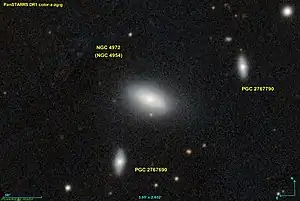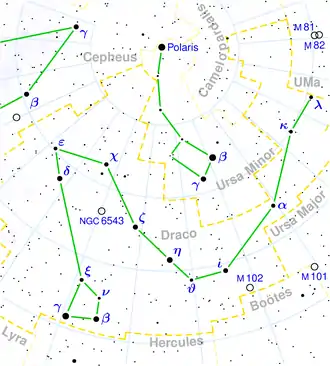NGC 4954
NGC 4954 ist eine 13,2 mag helle Linsenförmige Galaxie vom Hubble-Typ S0 im Sternbild Drache am Nordsternhimmel.
| Galaxie NGC 4954 | |
|---|---|
 | |
| AladinLite | |
| Sternbild | Drache |
| Position Äquinoktium: J2000.0, Epoche: J2000.0 | |
| Rektaszension | 13h 02m 19,9s[1] |
| Deklination | +75° 24′ 15″[1] |
| Erscheinungsbild | |
| Morphologischer Typ | S0?[1] |
| Helligkeit (visuell) | 13,2 mag[2] |
| Helligkeit (B-Band) | 14,2 mag[2] |
| Winkelausdehnung | 0,8′ × 0,6′[2] |
| Positionswinkel | 62°[2] |
| Flächenhelligkeit | 12,3 mag/arcmin²[2] |
| Physikalische Daten | |
| Rotverschiebung | 0.030961 ±0.000173[1] |
| Radialgeschwindigkeit | (9282 ±52) km/s[1] |
| Hubbledistanz vrad / H0 |
(421 ± 30) · 106 Lj (129,2 ± 9,1) Mpc [1] |
| Geschichte | |
| Entdeckung | Wilhelm Herschel |
| Entdeckungsdatum | 22. November 1797 |
| Katalogbezeichnungen | |
| NGC 4954, 4972 • UGC 8157 • PGC 44988 • CGCG 352-053, 353-008 • MCG +13-09-044 • IRAS 13009+7540 • GC 3393, 3409 • H III 937 • h 1527 • | |
Sie wurde zweimal entdeckt; zuerst am 22. November 1797 vom deutsch-britischen Astronomen Wilhelm Herschel mit einem 18,7-Zoll-Spiegelteleskop entdeckt,[3] der sie dabei mit „vF, S, iR, bM“ beschrieb (geführt als NGC 4972). Sein Sohn, der britische Astronom John Herschel notierte bei einer Beobachtung am 5. Mai 1831 „h.1527 [NGC 4954] and III.937 [NGC 4972]. These are not impossibly one nebula, but, as both R.A.s and P.D.s differ very much, they may be different and are therefore separately stated“ (Beobachtung geführt als NGC 4954).[4]
Weblinks
Einzelnachweise
- NASA/IPAC EXTRAGALACTIC DATABASE
- SEDS: NGC 4954
- Seligman
- Auke Slotegraaf: NGC 4954. Deep Sky Observer's Companion, abgerufen am 22. Februar 2015 (englisch).
This article is issued from Wikipedia. The text is licensed under Creative Commons - Attribution - Sharealike. The authors of the article are listed here. Additional terms may apply for the media files, click on images to show image meta data.
